Report Detail

Purchase Price: $4,750.00
U.S. Markets for Interventional Peripheral Vascular Disease Management Products and Technologies
For the purposes of this report, peripheral vascular disease (PVD) refers to those conditions that affect the vessels carrying blood to and from the extremities and the tissues/organs of the abdominal and pelvic cavities; and includes organic disorders,in which the condition is caused by structural blood vessel changes that may progress in severity (as opposed to functional ailments, in which the condition is unrelated to blood vessel defects and typically “comes and goes”).
The most frequently diagnosed form of PVD is peripheral artery disease (PAD), an occlusive condition that typically affects the upper and lower extremity arteries; other types of PAD include mesenteric artery disease, which affects the arteries that supply blood to visceral organs such as the intestines and liver, and renal artery disease, which affects the arteries that supply blood to the kidneys. The most common disease process leading to PAD is atherosclerosis, in which plaque build upon the inner walls of an artery results in lumen narrowing (stenosis) or blockage. Other forms of PVD include chronic venous insufficiency (CVI) and potentially life-threatening conditions such as aortic aneurysm and deep vein thrombosis (DVT) along with its associated condition, pulmonary embolism (PE).
It is estimated that 12 million to 14 million people in the United States (U.S.) suffer from PAD with 2 million to 3 million of these cases being serious enough to warrant intervention. The growing prevalence of PAD reflects both the aging of the U.S.population and the continuing growth in the number of people with PVD-related conditions such as diabetes, hypertension, and obesity.
Approximately 8 million people in the U.S. suffer from CVI; of these, more than 3 million develop venous ulcers. The percentage of the population with chronic venous leg ulcers increases exponentially with age (peak incidence occurs inwomen who are between the ages of 40 and 50 and in men who are between the ages of 70 and 80). Due to the greater longevity of women, the prevalence of CVI among women is approximately three times higher than among men.
Aortic aneurysms affect approximately 2 million people in the U.S., and nearly20,000 people in the country die each year from ruptured aortic aneurysms. Aortic aneurysm prevalence is increasing in the U.S., due in large part to the increasing number of elderly people, who constitute the bulk of the aortic aneurysm patient caseload. Aortic aneurysm is seen most often in people who are older than age 65, and the condition is more common in men than in women and in Caucasian males than in African American males.
According to the American Heart Association, there are approximately 25 millionpeople in the U.S. with a history of DVT, and 2 million people are newly diagnosedwith the condition each year. The greatest danger associated with DVT is PE, which occurs when a portion of the blood clot breaks off and travels with the return blood flow through the right side of the heart, potentially obstructing the pulmonary artery. According to available statistics, DVT-related PE complicates nearly 20% of all major surgical procedures performed in the U.S. and is believed to be the most common cause of preventable hospital mortality and the most frequent cause of deathassociated with childbirth. Annually in the U.S., approximately 600,000 people develop PE.
A variety of diagnostic and therapeutic methods are utilized in the management of patients with PVD. Over the forecast period covered by this report, the demand for noninvasive and invasive tools for the diagnosis and treatment of PVD will continue to grow. This demand will be fueled by expansion in the number of people living inthe U.S. as well as the number of people in the country suffering from chronic conditions such as diabetes, heart disease, and obesity, which may lead to the development of PVD; in addition, as the size of the elderly segment of the U.S.population increases in relation to the total population, the number of people with age-related peripheral vascular conditions, such as aortic aneurysm and PAD, will continue to climb.
The combined volume of interventional procedures performed in the U.S. for the diagnosis and treatment of PVD is projected to grow at a compound annual rate of 3.1% during the next half-decade, increasing from approximately 3,002,300 in 2008 to an estimated 3,496,400 in the year 2013. The combined U.S. market for interventional products for the diagnosis and treatment of PVD was valued at approximately $1,180.3 million in 2008; it is expected that sales of interventional PVD management products will expand at a compound annual rate of 9.2% during the forecast period covered by this report, reaching an estimated $1,831.7 million in the year 2013.
